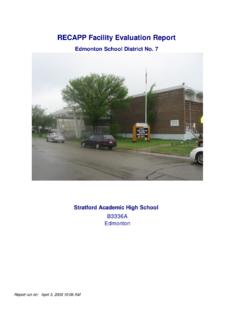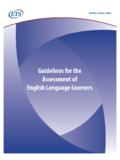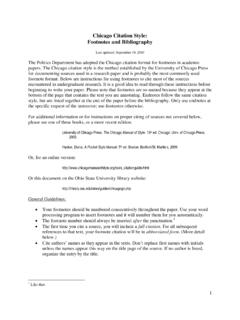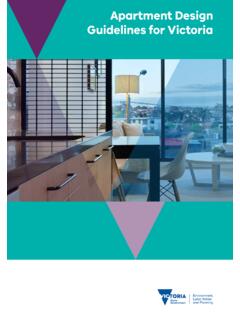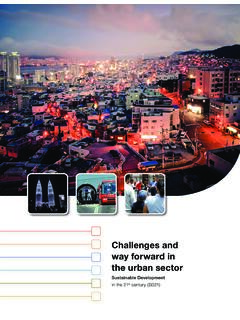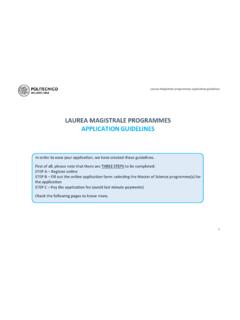Transcription of ARCHITECTURAL DESIGN GUIDELINES FOR SCHOOLS
1 ARCHITECTURALDESIGN GUIDELINESFOR SCHOOLSTECHNICAL SERVICES BRANCH Facility Planning & Architecture SectionNovember 2012 TABLE OF CONTENTSARCHITECTURAL DESIGN GUIDELINES FOR SCHOOLS INTRODUCTIONS ection 1: FIVE school PLANNING TYPOLOGIESS ection 2: FIVE EDUCATION MODEL TYPOLOGIESS ection 3: urban DESIGNS ection 4: SITE PLANNING & LANDSCAPINGS ection 5: COMPOSITION & AESTHETICSS ection 6: COMMUNITY INTEGRATION, INVOLVEMENT & IDENTITYS ection 7: EXPERIENTIAL SPACE PLANNINGS ection 8: UNIVERSAL DESIGNS ection 9: NEAT & ACTIVE DESIGNS ection 10: DESIGN FOR FLEXIBILITYS ection 11: MODULAR CLASSROOMSS ection 12: MATERIALITYS ection 13: SIGNAGE, GRAPHICS & ARTS ection 14: SUMMARYS ection 15: REFERENCES & LINKSA ppendix A: SAMPLE DESIGN DEVELOPMENT REPORT TABLE OF CONTENTSC over image:Lawrence Grassi Middle SchoolCanmore, AlbertaGEC ArchitecturePhoto by Architect010305081214161923273033363839 INTRODUCTIONARCHITECTURAL DESIGN GUIDELINES FOR SCHOOLS Alberta is to be known through its architecture as a place of innovation, excellence, technology, creativity, strength and beauty.
2 -Government of Alberta Infrastructure Department Policy Statement DESIGN Excellence , Policy Number O1241 The Ministry of Infrastructure advocates for the value and benefit of architecture and urban DESIGN in order to raise both the quality and the profile of Alberta s built environment, and to demonstrate leadership, collaboration, creativity and accountability in its pursuit of DESIGN of space and quality of experience are core ARCHITECTURAL concepts which are often challenging to express in the two-dimensional realm of spreadsheets and procedural documents. While poor DESIGN is readily apparent to most, good DESIGN can be so subtle that it may go completely unnoticed. In the process of satisfying demanding technical and temporal requirements for a new project, spatial and experiential quality may be overlooked or taken for granted, and although the finished product may be perfectly adequate, it may miss opportunities to fully engage and better serve its users and its a building typology, SCHOOLS offer an exciting opportunity for architects and owners to surpass the basic requirements of utilization formulas and functional programming.
3 DESIGN excellence recognizes the value of architecture to create an environment which enriches the lives of its users, inspires learning and creativity in teachers and students, and contribute to the vitality, pride, and identity of the guide provides an overview of best practices in contemporary school DESIGN from around the world, and is intended to serve as a point of departure for architects and owners in the holistic, artistic, and humanistic DESIGN of modern educational Services Branch, Fall 2012 ARCHITECTURAL DESIGN GUIDELINES FOR SCHOOLS section 1 school PLANNING TYPOLOGIESWhat are the five basic school planning TYPOLOGIES?Top Image:Denver school of Science & TechnologyDenver, Colorado, USAK lipp ArchitecturePlan by architect Bottom Photo:Raholt Secondary SchoolRaholt, Eidsvoll, NorwayKristin Jarmund ArchitectsPhoto by ArchitectARCHITECTURAL DESIGN GUIDELINES FOR SCHOOLSBACKGROUND The spatial organization of SCHOOLS typically responds to teaching pedagogy, student demographics and site restraints, however, most SCHOOLS exhibit characteristics of one or more of five basic planning typologies:1: SPINE/STREETM ajor school functions are situated along a central linear space (simplifies wayfinding and reduces secondary circulation).
4 The spine/street is an active, inhabited space - a building focal point rather than a simple conduit. Situating the main entrance at one end establishes a strong axis which is often expressed in the massing of the building. High ceilings and clerestory windows for natural light and ventilation, as well as careful selection of materials and furnishings creates a welcoming, desirable heart of the : CITY/TOWNthe urban /city layout is reinterpreted as a loose composition of forms within a matrix of open, flexible social spaces. Classrooms are informally located around the library and town hall (main 01gathering space). the resultant plazas , streets , and parks create flexible, student-scaled learning and instructional spaces; common in primary SCHOOLS where the familiarity of the city/town fabric instills a sense of community and : ATRIUM/OFFICEM odeled after the typical office environment, this scheme is best suited to large multi-storey high SCHOOLS .
5 A full height atrium serves as the main organizational hub, bringing daylight into deep floorplates and creating a unified, central gathering and circulation node. Open floor plans utilize glazed partitions to access light and views, and to define classroom : STRAWBERRY/LEARNING CLUSTERC lassrooms, support, and flexible spaces are clustered into smaller groups ( strawberries ) and connected by a central core providing circulation, social and shared spaces. SCHOOLS are divided into less intimidating faculties and may specialize in particular subjects or simply foster closer student/staff relationships. The core may include most or all of the characteristics of the Spine/Street typology (also referred to as Strawberry/Spine ). 5: COURTYARDP roviding security, visual focus, and a sheltered microclimate, courtyards vary in size and shape while offering flexibility for year-round activities.
6 Provision of a courtyard may increase the amount of building envelope and circulation space required (especially if corridors are single-loaded), however benefits include better access to natural light, views, ventilation and more pleasant interior spaces. ARCHITECTURAL DESIGN GUIDELINES FOR SCHOOLS02 Top Photo:Orestad College Copenhagen, Denmark3 XNPhoto by Adam Mork Middle Photo:Bristol Metropolitan College Bristol, UKWilkinson Eyre ArchitectsPlan by Architect Bottom Photo:Oslo International school Oslo, NorwayJarmund Vigsnaes As ArkitekterPlan by Architectsection 2 EDUCATION MODEL TYPOLOGIESWhat are the five basic education model TYPOLOGIES?Top Photo:St. Luke s CE Primary SchoolWolverhampton, UKArchitypePhoto by Leigh SimpsonBottom Photo:Corlaer College Nijkerk, NetherlandsBroekbakema Photo by Rob T Hart PhotographyARCHITECTURAL DESIGN GUIDELINES FOR SCHOOLSBACKGROUND Approaches to the philosophy and delivery of education are constantly evolving in response to changing attitudes, technologies, and evidence-based DESIGN .
7 Within this broad scope, however, commonalities exist, all of which may inform the DESIGN , construction, and use of : CLASSROOMThe traditional method of educational instruction, characterized by 25-30 students seated in a classroom and taught a standardized curriculum within a fixed : STUDIOMost commonly used at the junior and senior high level, studio setups promote vocational, hands-on learning, often utilizing specialized technologies and equipment within a workplace-like : OFFICEW ithin an open plan layout, students undertake personalzed learning at individual workstations, similar to a standard office environment. Educational agendas and topic based projects incorporate student input and are undertaken individually or in small or large : school WITHIN A SCHOOLC ommon in higher education systems, sub- SCHOOLS within the overall school facility are equipped to teach a full curriculum of studies semi-autonomously.
8 Ability and attainment indicate how long a student spends at a particular level, while students of varying ages provide cooperative peer support and : FACULTYB ased on specific subject clusters, this model allows individual subject departments to identify and develop specialized curricular, spatial, and visual identity requirements tailored to a particular area of instruction within a larger DESIGN GUIDELINES FOR SCHOOLS04 Top Photo:Saltire CentreGlasgow, UKBuilding DESIGN PartnershipPhoto by David BarbourMiddle Photo:Aurinkolahti Comprehensive SchoolJeskanen-Repo-Teranne ArkkitehditHelsinki, FinlandPlan by Architect Bottom Photo:Bristol Metropolitan College Bristol, UKWilkinson Eyre ArchitectsDrawing by Architectsection 3 urban DESIGNHow does good urban DESIGN contribute to the VALUE of a school within a community?
9 How does the school respond to the three scales of context: CITY, NEIGHBOUR-HOOD, AND SITE?Photo:High Line ParkNew York, New York, USA Diller Scofidio + RenfroPhoto uncredited, from DESIGN GUIDELINES FOR SCHOOLSVALUE A school is a symbol of the community, in built form; functionally it should be extended and promoted as a place of community assembly. Good urban DESIGN improves the human experience of the city through the thoughtful interplay of buildings, transportation, outdoor public spaces and landscaping to create a vibrant, safe, and pedestrian-oriented environment. As SCHOOLS are highly public and highly visible institutions within the community, their architecture should be welcoming and extroverted. time invested in understanding where the school is located, who uses it, and how, establishes the school as an integral part of the community by reflecting these qualities in built form.
10 A sense of pride, place and identity is strengthened when the community can relate to the buildings within Identify and respond to the unique patterns, historical buildings/precedents, geographic features, districts and boundaries within the 05project context. ARCHITECTURAL responses need not replicate a particular style, but may allude to massing, materials or proportions reflective of the surrounding built environment. Explore what differentiates the project from others of similar type, scale, and Identify opportunities for pedestrian oriented, mixed use activities within the school grounds, such as community gardens, playgrounds, or public art. Incorporate attractive hard and soft landscaping, fixtures, furniture, and lighting to enliven and enhance the streetscape.

